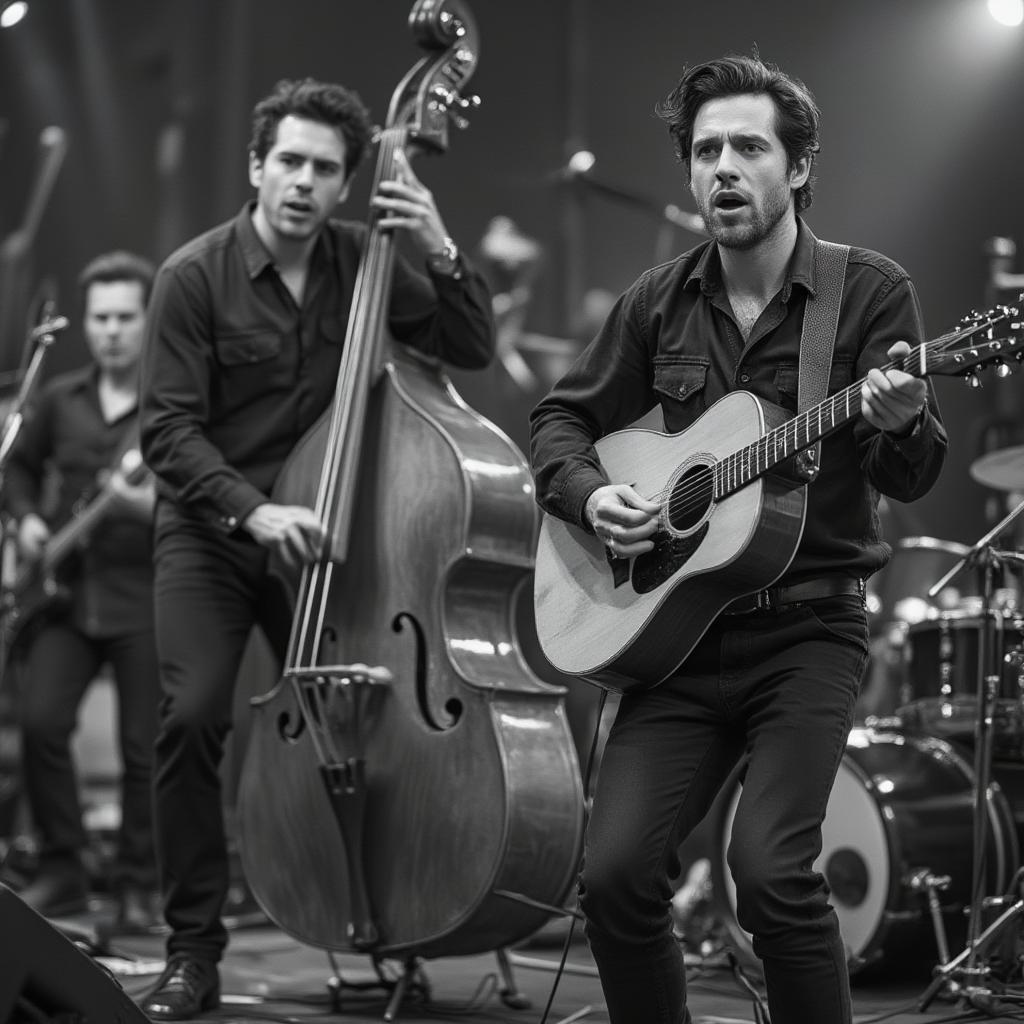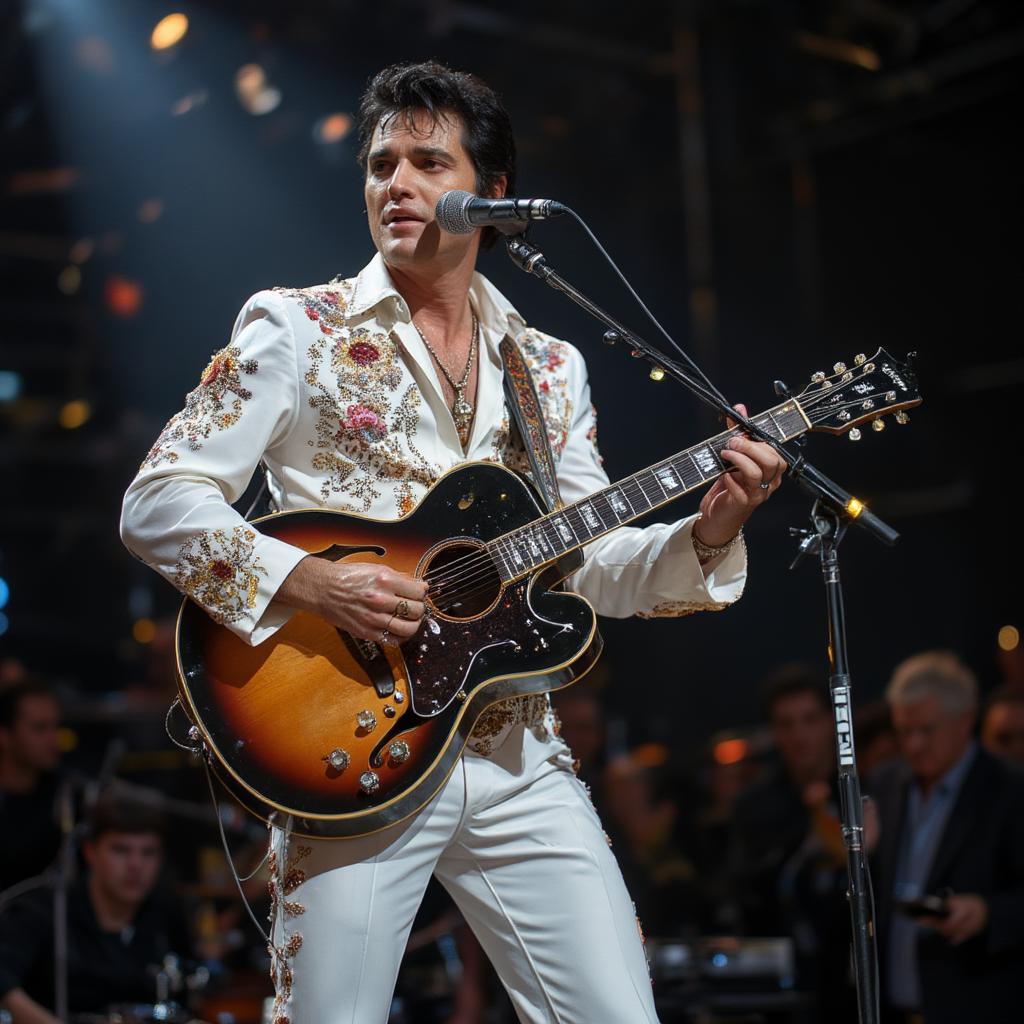The Genesis of Groove: Unearthing the Birth of Rock and Roll

The Birth Of Rock And Roll wasn’t a single event, but rather an explosive collision of cultures and sounds. It’s a story as vibrant and unpredictable as the music itself, a tale woven from the threads of blues, gospel, country, and a rebellious spirit that resonated with a generation on the cusp of change. So, how did this genre, with its electrifying guitars and raw energy, take hold? Let’s delve into the very heart of rock and roll.
Roots of Rebellion: Precursors to the Rock and Roll Revolution
The early 20th century witnessed a musical landscape largely defined by the refined elegance of jazz and the soulful narratives of the blues. These genres, born from the African American experience, laid the foundation for something completely new. Blues, with its raw emotionality and driving rhythms, provided the backbone, while gospel music infused a sense of spiritual fervor. Country music, often overlooked, also played a crucial role, bringing in its twangy guitars and relatable storytelling. The mix of these seemingly disparate styles formed the fertile ground from which rock and roll would soon spring. To truly grasp the birth of rock and roll, it’s essential to understand that it wasn’t simply a new sound, but a cultural revolution bubbling beneath the surface.

The Spark: Technological Advancements and Post-War Optimism
The end of World War II brought with it a surge of optimism and a thirst for something new. Suddenly, technologies like the electric guitar, once a novelty, became accessible and affordable, opening up new avenues for sonic exploration. The rise of independent radio stations further fueled the flames, giving airtime to these emerging artists who weren’t always in the spotlight of the mainstream music industry. These factors, combined with a changing social landscape, created a perfect storm for the birth of rock and roll to truly erupt. This is where we see the sounds begin to shift, taking on a faster pace and more infectious rhythm. It was all part of a bigger picture of social change.
The Architects of Attitude: Pioneers of Rock and Roll
While it’s difficult to pinpoint a singular moment of origin, there are certain artists who were instrumental in shaping the sound and spirit of rock and roll. Chuck Berry, with his iconic guitar riffs and storytelling lyrics, became a leading figure, his music capturing the exuberance of youth. Little Richard, known for his flamboyant style and high-energy performances, brought an unparalleled sense of showmanship to the genre. Meanwhile, artists like Elvis Presley infused the raw energy of blues and country with a charismatic stage presence, making him the face of the rock and roll rebellion. His impact transcended music, influencing fashion, attitudes, and the very definition of cool.

These early pioneers were not just musicians, they were cultural disruptors, their music challenging the status quo and resonating with a generation eager for change. They weren’t simply playing music; they were creating a movement. Their influence extended far beyond the realm of music, shaping youth culture and forever altering the landscape of popular entertainment. For those seeking the true birthplace of rock and roll, it’s often considered to be found within the various recording studios and clubs that these groundbreaking artists frequented.
Sound of the Revolution: The Defining Characteristics
So, what exactly makes a song rock and roll? It’s more than just the electric guitars and driving drumbeats. It’s the fusion of blues scales with a faster tempo, often emphasizing the backbeat – a characteristic that makes you want to tap your foot and move your body. It’s the raw and often unpolished vocals, the emphasis on feeling rather than technical perfection, the lyrics about love, rebellion, and the everyday struggles of youth. All of these elements combine to create a sound that is undeniably raw, honest, and undeniably rock and roll. This distinct sound allowed for a space where people felt heard and understood. The feeling is that these artists are playing the music with you, not just to you.
“The raw energy and the feeling of freedom that rock and roll provided was something entirely new. It spoke to the youth of a generation that was ready to break free from the constraints of the past,” says Dr. Eleanor Vance, a leading music historian.
The Evolution of the Riff: A Look at the Decades Following
The birth of rock and roll was a seminal moment, but it wasn’t the end of the story – it was just the beginning. The genre quickly evolved and diversified, branching out into numerous subgenres. The British Invasion, spearheaded by bands like The Beatles and The Rolling Stones, infused rock and roll with new energy and perspectives. The 1970s saw the rise of hard rock and glam rock, further pushing the boundaries of musical expression. It is within these evolutions that we can truly see the lasting legacy and influence of those early pioneers. It wasn’t a sound that remained static. The genre was always changing and reflecting the times.
50s Rock Music and Its Lasting Legacy
The early days of rock, specifically the 50s rock music, weren’t just a flash in the pan. They laid the groundwork for all that was to come. Even today, decades later, the echoes of those raw, energetic performances can be heard in the music of countless contemporary artists. The rebellious spirit, the driving rhythms, the focus on feeling over perfection – these are all elements that continue to make rock and roll a powerful and enduring force. The influence of these pioneers is undeniable and their music is still inspiring generations of artists.
“The impact of the 50s on music cannot be overstated,” notes Professor Marcus Chen, an expert in cultural studies. “It was a period of profound change that not only influenced music but also shaped society in many other ways.”
Beyond the Music: Rock and Roll as a Cultural Force
Rock and roll was more than just a musical genre. It was a cultural phenomenon, a catalyst for social change and a symbol of youthful rebellion. It challenged the norms of the time, questioning authority and celebrating individuality. It empowered a generation to find its own voice and to express itself freely. Even the fashion trends, the hairstyles, and the language used reflected this revolutionary spirit. The impact was felt far beyond the music, shaping the cultural landscape in profound and lasting ways. The music was the soundtrack to a generation ready for change.
The Role of Radio and the Spread of Rock
Radio played an essential part in the widespread adoption of rock and roll music. Independent radio stations, breaking free from the conventional norms, began to broadcast the music that had been previously excluded from mainstream audiences. This allowed the genre to reach a wider audience, contributing to its exponential growth. The accessibility of the music was a key factor in its rapid success and it’s undeniable that radio was vital in making the sound so widely known. It’s a reminder of the power of media in shaping culture.
“The radio waves carried the spirit of rock and roll to every corner of the world. It was the perfect vessel to amplify its impact,” states renowned musicologist, Dr. Anika Sharma.
The Enduring Resonance: Why Rock and Roll Still Matters
Even today, long after the golden age of its birth of rock and roll, the genre continues to resonate with audiences around the globe. Its raw energy, rebellious spirit, and emphasis on authenticity remain as relevant as ever. It is a timeless genre because it taps into something primal within us, a deep-seated desire for freedom and self-expression. The music has evolved and adapted to new eras but the core elements remain the same. That’s why rock and roll still matters and will continue to inspire countless more artists to come. You can still feel the same raw, unbridled energy in many contemporary acts, a direct line to the sounds of the past.

To dive deeper into the story of how the music landscape evolved, explore the legacy of influential rock n roll artists that pushed the boundaries of the genre, and for an example of the influence that rock and roll has had across the globe, check out the story of duran duran rock and roll hall of fame. It’s clear the genre has had an enduring appeal and has woven itself into the very fabric of contemporary music. If you are looking for something with a vintage feel check out the 70s rock and roll sound. Alternatively, for the original sounds, look into the 50s rock music, the birthplace of this iconic genre.
Conclusion
The birth of rock and roll was a cultural earthquake that reshaped the world of music. It was a collision of genres, a spark of youthful rebellion, and a celebration of individuality. From its bluesy roots to its electrifying evolution, rock and roll has proven to be a powerful and enduring force, continuing to inspire new generations of musicians and listeners alike. The raw emotion and freedom found within the genre continues to captivate us, ensuring its legacy lives on forever.
FAQ About the Birth of Rock and Roll
1. What were the main influences behind the birth of rock and roll?
The birth of rock and roll was influenced by a mixture of genres, primarily blues, gospel, and country music, with a dash of boogie-woogie piano. These genres formed the foundation upon which rock and roll was built. The cultural shifts of the post-war era also had a significant impact, promoting new ideas and ways of thinking.
2. Who are considered the key pioneers of rock and roll?
Key pioneers of rock and roll include Chuck Berry, Little Richard, Elvis Presley, and Sister Rosetta Tharpe, among others. Their distinctive styles and groundbreaking performances helped to define the genre and paved the way for future artists. They each brought their own flavor to the mix.
3. Where did rock and roll originate?
Rock and roll’s true origins cannot be pinned down to just one place. Many artists from across the United States, especially the South, were simultaneously experimenting with a new sound, creating a melting pot for the musical genre.
4. Why did rock and roll become so popular so quickly?
Rock and roll quickly became popular because it resonated with the youth of the time, embodying a sense of rebellion and freedom. Its raw energy and catchy rhythms were a stark departure from the popular music of the era. Radio also played a significant role in popularizing rock and roll.
5. What are the defining characteristics of rock and roll music?
The defining characteristics of rock and roll music include a strong backbeat, electric guitars, and often lyrics about love, cars, and rebellion. It is usually played at a fast tempo and has a raw, often unpolished sound. The attitude of the music also contributes to its identity.
6. How has rock and roll influenced other genres of music?
Rock and roll has had a massive impact on other genres of music, influencing styles like hard rock, heavy metal, punk rock, and pop. Its emphasis on raw emotion and energy can be seen in numerous musical genres of the past and present. The spirit of rock and roll has touched countless others.
7. Is rock and roll still relevant today?
Yes, rock and roll is still very relevant today. Although the music landscape has evolved, its impact on current music is undeniable. The core values of rock and roll – rebellion, authenticity, and freedom of expression – continue to resonate with audiences worldwide. It remains an important and timeless music genre.




